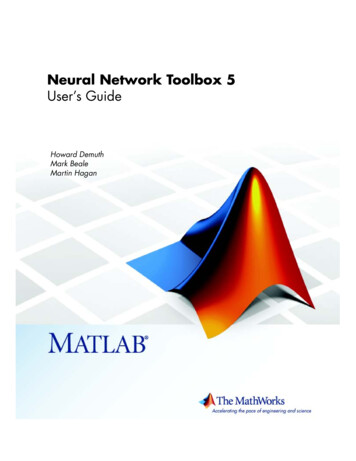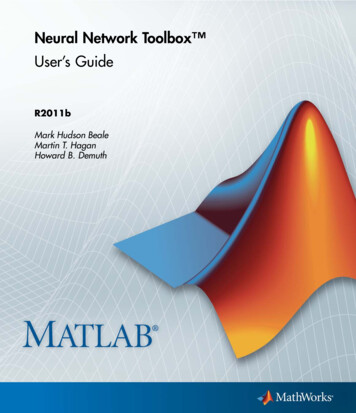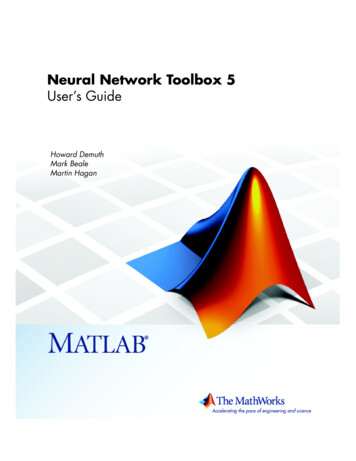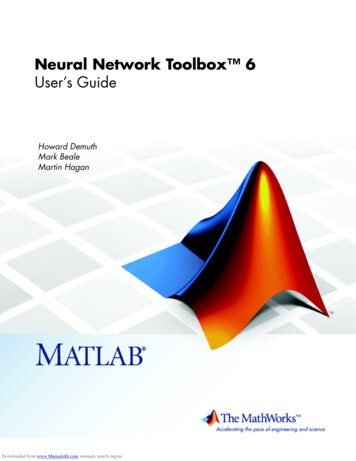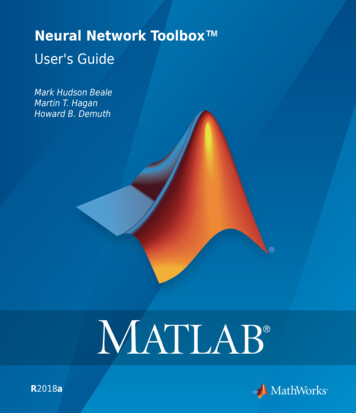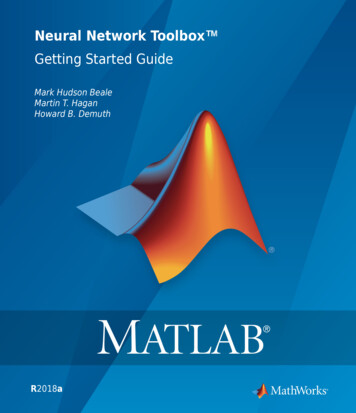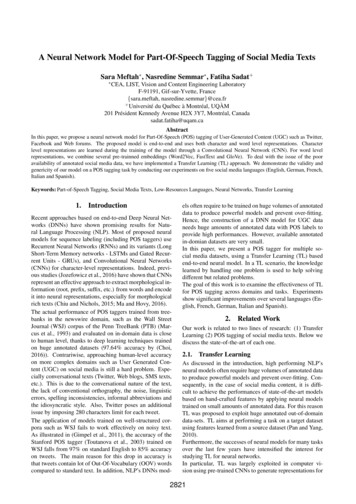
Transcription
A Neural Network Model for Part-Of-Speech Tagging of Social Media TextsSara Meftah , Nasredine Semmar , Fatiha Sadat CEA, LIST, Vision and Content Engineering LaboratoryF-91191, Gif-sur-Yvette, France{sara.meftah, nasredine.semmar}@cea.fr Université du Québec à Montréal, UQÀM201 Président Kennedy Avenue H2X 3Y7, Montréal, Canadasadat.fatiha@uqam.caAbstractIn this paper, we propose a neural network model for Part-Of-Speech (POS) tagging of User-Generated Content (UGC) such as Twitter,Facebook and Web forums. The proposed model is end-to-end and uses both character and word level representations. Characterlevel representations are learned during the training of the model through a Convolutional Neural Network (CNN). For word levelrepresentations, we combine several pre-trainned embeddings (Word2Vec, FastText and GloVe). To deal with the issue of the pooravailability of annotated social media data, we have implemented a Transfer Learning (TL) approach. We demonstrate the validity andgenericity of our model on a POS tagging task by conducting our experiments on five social media languages (English, German, French,Italian and Spanish).Keywords: Part-of-Speech Tagging, Social Media Texts, Low-Resources Languages, Neural Networks, Transfer Learning1.IntroductionRecent approaches based on end-to-end Deep Neural Networks (DNNs) have shown promising results for Natural Language Processing (NLP). Most of proposed neuralmodels for sequence labeling (including POS taggers) useRecurrent Neural Networks (RNNs) and its variants (LongShort-Term Memory networks - LSTMs and Gated Recurrent Units - GRUs), and Convolutional Neural Networks(CNNs) for character-level representations. Indeed, previous studies (Jozefowicz et al., 2016) have shown that CNNsrepresent an effective approach to extract morphological information (root, prefix, suffix, etc.) from words and encodeit into neural representations, especially for morphologicalrich texts (Chiu and Nichols, 2015; Ma and Hovy, 2016).The actual performance of POS taggers trained from treebanks in the newswire domain, such as the Wall StreetJournal (WSJ) corpus of the Penn TreeBank (PTB) (Marcus et al., 1993) and evaluated on in-domain data is closeto human level, thanks to deep learning techniques trainedon huge annotated datasets (97.64% accuracy by (Choi,2016)). Contrariwise, approaching human-level accuracyon more complex domains such as User Generated Content (UGC) on social media is still a hard problem. Especially conversational texts (Twitter, Web blogs, SMS texts,etc.). This is due to the conversational nature of the text,the lack of conventional orthography, the noise, linguisticerrors, spelling inconsistencies, informal abbreviations andthe idiosyncratic style. Also, Twitter poses an additionalissue by imposing 280 characters limit for each tweet.The application of models trained on well-structured corpora such as WSJ fails to work effectively on noisy text.As illustrated in (Gimpel et al., 2011), the accuracy of theStanford POS tagger (Toutanova et al., 2003) trained onWSJ falls from 97% on standard English to 85% accuracyon tweets. The main reason for this drop in accuracy isthat tweets contain lot of Out-Of-Vocabulary (OOV) wordscompared to standard text. In addition, NLP’s DNNs mod-els often require to be trained on huge volumes of annotateddata to produce powerful models and prevent over-fitting.Hence, the construction of a DNN model for UGC dataneeds huge amounts of annotated data with POS labels toprovide high performances. However, available annotatedin-domian datasets are very small.In this paper, we present a POS tagger for multiple social media datasets, using a Transfer Learning (TL) basedend-to-end neural model. In a TL scenario, the knowledgelearned by handling one problem is used to help solvingdifferent but related problems.The goal of this work is to examine the effectiveness of TLfor POS tagging across domains and tasks. Experimentsshow significant improvements over several languages (English, French, German, Italian and Spanish).2.Related WorkOur work is related to two lines of research: (1) TransferLearning (2) POS tagging of social media texts. Below wediscuss the state-of-the-art of each one.2.1.Transfer LearningAs discussed in the introduction, high performing NLP’sneural models often require huge volumes of annotated datato produce powerful models and prevent over-fitting. Consequently, in the case of social media content, it is difficult to achieve the performances of state-of-the-art modelsbased on hand-crafted features by applying neural modelstrained on small amounts of annotated data. For this reasonTL was proposed to exploit huge annotated out-of-domaindata-sets. TL aims at performing a task on a target datasetusing features learned from a source dataset (Pan and Yang,2010).Furthermore, the successes of neural models for many tasksover the last few years have intensified the interest forstudying TL for neural networks.In particular, TL was largely exploited in computer vision using pre-trained CNNs to generate representations for2821
novel tasks; some of the parameters learned on the sourcedataset are used to initialize the corresponding parametersof the CNNs for the target dataset.In the past few years, few studies have been conducted onTL for neural based models in the field of NLP. It consistsin performing a task on a low-resource target problem usingfeatures learned from a high-resource source problem. Forinstance, TL has been successfully applied in neural speechprocessing and machine translation (Zoph et al., 2016).Two studies have been recently performed on TL for neural networks based models in sequence labeling: Yang etal. (2017) examined the effects of TL for deep hierarchical recurrent networks across domains, applications, andlanguages, and showed that significant improvement canbe obtained. Lee et al. (2017) used cross-domain TL forNamed Entity Recognition (NER) (specifically patient notede-identification), and showed that TL may be especiallybeneficial for a target dataset with small number of examples.2.2.to the former works. The model proposed in (Gui et al.,2017) requires that labeled in-domain-data and labeled outof-domain data share the same tag-set (a mapping is necessary in case of tag-sets mismatch).3.This work is built on the basis of the recently published paper (Meftah et al., 2017), where cross-domain TL was successfully used for English tweets POS tagging by exploitingavailable huge amounts of POS labeled corpora of a similardomain (standard English). The knowledge learned on theparent neural network trained on enough standard Englishlabeled data was transferred to initialize the child network,further fine-tuned on small annotated English Twitter corpus. Nevertheless, the present paper includes the followingnew contributions: We investigate a second scenario, cross-task TL,where the parent network is trained on in-domain dataannotated with Named Entities (NE). We show that TL method is efficient on multiple socialmedia languages (English, French, Spanish, Germanand Italian).Part-Of-Speech Tagging of Social MediaTextsPOS tagging is a sequence labeling problem, by assigningto each word its disambiguate part-of-speech (Verb, Noun,Adjective, etc.) in the sentential context in which the wordis used. This information is useful for higher-level NLP applications such as semantic relations extraction, sentimentanalysis, automatic summarization and machine translation.Most performing traditional POS tagging models for socialmedia content are linear statistical models, including Hidden Markov Models (HMM), Maximum Entropy MarkovModels (MEMMs), Conditional Random Fields (CRF) andlinear classifiers like SVM-based taggers.There are two principal state-of-the-art works for Englishtweets POS tagging, both based on hand-crafted features,Ritter et al. (2011) published a set of 787 hand-annotatedEnglish tweets and proposed in (Derczynski et al., 2013) amodel based on hidden Markov Models and a set of normalization rules, external dictionaries and lexical features.Gimpel et al. (2011) and Owoputi et al. (2013) constructed1827 and 547 hand-annotated tweets, respectively, usingthe same tag-set. They proposed a model based on Firstorder maximum entropy Markov model (MEMM), engineered features like brown clustering and lexical features.Nooralahzadeh et al. (2014) proposed a POS tagging system for French Social Media content using Conditional random fields (CRFs) with a set of several hand-crafted features.These models rely heavily on hand-crafted features and taskspecific resources (morphological, orthographic and lexicalfeatures and external resources such as gazetteers or dictionaries). However, such task-specific knowledge is costly todevelop and making sequence labelling models difficult toadapt to new tasks or new domains.Recently a neural network model for English tweets POStagging was proposed by Gui et al. (2017) (TPANN),they used Adversarial Neural Networks to leverage hugeamounts of unlabeled tweets and labeled out-of-domaindata (WSJ). TPANN achieves high performances comparedContributions We analyze how cross-task TL may address the issueof the low-availability of annotated data and improveperformances.4.Neural Model ArchitectureThe neural model that we use for TL experiments is thesame used in (Meftah et al., 2017), based on bidirectional hierarchical Gated Recurrent Units (GRUs). Figure2 shows an overview of the model’s architecture1 .4.1.Features RepresentationIn order to preserve both semantic and syntactic information of words, each word from the input sequence isrepresented by a combination of two vectors of features,character-level and word-level embedding. Therefore, eachword in the input sentence is represented by a combinationof two vectors:1. Pre-trained words embedding: We initialize wordlevel embedding with a concatenation of different preretrained words embedding (details in section 6.3.) toaccurately capture words’ semantics.2. Character level embedding: To learn orthographic features at the character level, we use a CNN architecturesimilar to that of Ma and Hovy (2016). As illustratedin figure 1. Each word is represented with a v ldimensional matrix, next it’s embedded into a d ldimensional matrix, where v is character’s vocabularysize, l is the maximal length of words and d is character embedding’s dimension. Then, we take the character embeddings and apply (30 3)-stacked convolutional layers, followed by a max-pooling operation.Finally, the result is passed to a fully-connected layerusing a Rectifier Linear Unit (ReLU) activation function.1The model’s architecture is the same among all datasets andtasks.2822
Figure 1: Convolutional Neural Network architecture forcharacter-level embedding.4.2.Sequence Labelling with Gated RecurrentUnits (GRUs) LayerWord vectors (the combination between character level embedding and word level embedding CNN) are fed into a 100dimension Gated Recurrent Units (GRUs) layer, a variant ofRNNs.Let (x1 , x2 , ., xt , ., xn ) the input sequence of the GRUslayer, which is in our case a sequence of n D-dimensionalword vectors, where n is sentence’s length and D is wordvectors’ dimension.Let ht be the GRU hidden state at time-step t. Formally, aGRU unit at a time-step t takes xt and the previous hiddenstate ht 1 as input, and outputs the current hidden state ht .Each gated recurrent unit can be expressed as follows:rt σ(Wrx xt Wrh ht 1 )(1)zt σ(Wzx xt Wzh ht 1 )(2)ĥt tanh(Whx xt Whh (rt ht 1 ))(3)ht zt ht 1 (1 zt ) ĥt(4)Where W’s are model parameters of each unit, ĥt is a candidate hidden state that is used to compute ht , σ is anelement-wise sigmoid logistic function defined as σ(x) 1/(1 e x ), and denotes element-wise multiplicationof two vectors. The update gate zt controls how muchthe unit updates its hidden state, and the reset gate rt determines how much information from the previous hiddenstate needs to be reset.4.3.Figure 2: Overall system design. First, the system embeds each word of the current sentence into two representations: character level representation using a CNN networkand a word level representation by combining different pretrained models. Then, the two representations are combined and fed into a bidirectional GRU layer, the resultingvector is fed to a fully connected layer and finally a softmaxlayer to perform POS tagging.We experiment two scenarios of TL. The first scenariois cross-domain transfer; knowledge is transferred from asource domain to a target domain. In our case, the sourcedomain is the standard form (well-established) of a language and the target domain is the social media text ofthe same language. The source and the target problems aretrained for the same task (POS tagging), even if source andtarget datasets do not share the same tag-set.As illustrated in the figure 3, we have a parent neural network Np with a set of parameters θp splitted into two sets:θp (θp1 , θp2 ). And a child network Nc with a set of parameters θc splitted into two sets: θc (θc1 , θc2 ).(1) We learn the parent network on annotated data from thesource problem on a source dataset Ds . (2) We transferweights of the first set of parameters of the parent networkNp to the child network Nc : θc1 θp1 . (3) Then, the childnetwork is fine-tuned to the target problem by training it onthe target dataset Dc .Fully-connected Layer and Softmax LayerThe output of the forward GRUs and the backward GRUs ateach time-step are combined and fed through a 80 dimension linear (fully connected) layer with a ReLU activation,followed by a final dense layer with a softmax activation togenerate a probability distribution over the output classes ateach time-step.5.Transfer Learning ApproachTL is applied to address the problem of the need in annotated data for POS tagging of social media texts. It consistsin learning a parent neural network on a source problemwith enough data, then transferring a part of its weights torepresent data of a target problem with few training examples.Figure 3: Cross-domain Transfer Learning scheme.The second scenario is cross-task transfer; the source andthe target problems share the same domain and the samelanguage (social media text of the same language). However, tasks are different (The source problem’s task is NERand the target’s is POS tagging) to exploit the underlyingsimilarities of the two tasks.As illustrated in the figure 4, the parent neural network andthe child network share the same first set of parameters (Thefeature extractor) : θp1 θc1 θ1 .θ1 are jointly optimized by the two tasks, while task specificparameters θc2 and θp2 are trained for each task separately.2823
al., 2003), a POS-annotated French newspaper corpus.We evaluate our approach on two publicly available POSlabeled User Generated (UG) French content datasets: The French web 2.0 (Fr2.0) (Seddah et al., 2012) isa set of 1700 sentences extracted from various typesof French Web. (1) Micro-blogging: Facebook andTwitter. (2) web forums: French health forum DOCTISSIMO3 and video games website JEUXVIDEOS4 .The tag-set includes 28 POS tags from FTB, plus combined tags for contracted tokens. For instance, thenon-standard French contraction tes (widely used byFrench web’s users), which stands for tu es, wouldhave been tagged CLS and V (subject clitic and finiteverb) in FTB. The non-standard contracted token tesis then tagged CLS V. And specific tags to social media, including HT and RT. Twitter at-mentions as wellas urls and e-mail addresses have been tagged NPPwhich is the main difference with other annotations ofUG content.Figure 4: Cross-task Transfer Learning scheme.6.6.1.Experimental SetupDatasetsWe use two types of source datasets for parent neural network training: (1) large out-of-domain POS-labeled datafrom resource-rich domains for the first TL scenario, and(2) NE-labeled in-domain data for the second scenario. Forchild neural network model fine-tuning, we use small POSlabeled in-domain datasets.In this section, we report the source and target datasets foreach language, on which we perform our evaluations. Thestatistics of the datasets2 are described in table 1.6.1.1. EnglishAs a source dataset for English experiments, we use a standard English corpus, the Wall Street Journal (WSJ) partof the PTB, annotated with 36 POS tags.We evaluate our approach on three target datasets. TheNPS IRC Chat Corpus (Forsythand and Martell, 2007)of 10,567 posts gathered from various online chat services.And two Twitter datasets: The T-PoS corpus of 787 hand-annotated Englishtweets, introduced by (Ritter et al., 2011), which usesthe same tag-set as PTB’s (Marcus et al., 1993), plusfour Twitter special tags: URL for urls, HT for hashtags, USR for username mentions and RT for retweetsignifier (40 tags in total). For our experiments on TPoS, we use the same data splits used in (Derczynskiet al., 2013); 70:15:15 into training, development andtest sets named T-train, T-dev and T-eval. The ARK corpus was published on two parts, thefirst, Oct27 of 1827 hand-annotated English tweets,published in (Gimpel et al., 2011) and the second,Daily547 of 547 tweets published by Owoputi et al.(2013), using a novel and coarse grained tag-set (25tags). For example, its V tag corresponds to any verb,conflating PTB’s VB, VBD, VBG, VBN, VBP, VBZ,and MD tags. We split the Oct27 dataset into trainingset and development-set (70:30) (data splits portionsare not mentioned in original papers) and Daily547 asa test set.6.1.2. FrenchAs a source dataset for French experiments, we use a standard French corpus, French-Tree-Bank (FTB) (Abeillé et ExtremeUGC dataset (UGC) (Alonso et al., 2016):contains user-generated content from three differentsources. Two of them are logs of multi-player videogame chat sessions: MINECRAFT and LEAGUE OFLEGENDS, the last one is cooking-related user questions from MARMITON, a popular cooking Frenchwebsite. Datasets are annotated with the same schemeas the Fr2.0.6.1.3. Spanish, Italian and German:The xLiMe Twitter Corpus (Rei et al., 2016): is a Multilingual Social Media Linguistic Corpus, contains manuallyannotated Spanish, German and Italian tweets 5 . The corpus is annotated with POS tags and NE. The POS tag-setconsists of the Universal Dependencies tag-set, plus Twitter specific tags based on (Gimpel et al., 2011). For NE,they used the same tag-set used in CoNLL-2003 SharedTask (Person, Location, Organization, and Miscellaneous).Since there is no standard training/dev/test data split forxLime corpora, we randomly split it 80:10:10 into training,development and test sets.6.2.6.2.1. English Derczynski et al. (2013) performed experiments onT-PoS corpus. For training, they used T-train (2.3Ktokens), 50K tokens from the WSJ part of the PTBand 32K tokens from the NPS IRC corpus, achievingan accuracy of 88.69% on T-eval. Furthermore, theyachieved 90.54% token accuracy using supplementary1.5M training tokens annotated by istic-Corpus.html42All corpora are in the CoNLL format, they are already tokenized.BaselinesWe compare the performance of our system to performances of prior works described in section 2.2.:2824
tSourceTargetSourceTargetCorpusWSJNPST-POSArk dataset (Oct27 Daily547)FTBFrench Web 2.0ExtremeUGCxLime Spanish NERxLime Spanish POSxLime German NERxLime German POSxLime Italian NERxLime Italian POSTaskPOSPOSPOSPOSPOSPOSPOSNERPOSNERPOSNERPOS# Sentences67,78610,5677871,827 54721,6341,7009747,6687,6683,4003,4008,6018,601# Tokens1,2M45,00015,00026,594 62,269162,269Table 1: Statistics of the different source and target datasets used in this paper. Owoputi et al. (2013) performed experiments on TPos, Ark and NPS corpora, achieving 90.40%, 93.20%and 93.4% accuracy respectively.1. Word2vec (Mikolov et al., 2013), trained on part ofGoogle News dataset (about 100 billion words). Themodel contains 300-dimensional vectors for 3 millionwords. Gui et al. (2017) performed experiments on T-PoS,ArK and NPS datasets, achieving 90.92%, 92.80% and94.1% accuracy respectively. For training, they leverage 1,17M token from unlabeled tweets and more than1,17M from labeled WSJ. In order to use WSJ labeleddata in experiments on ARK dataset, they performed amapping between PTB and ARK tag-sets.2. FastText (Bojanowski et al., 2016), which is very similar to Word2vec (Using SkipGram) but it also usessub-word information in the prediction model. FastText Facebook embedding is trained on Wikipedia for294 languages and contains 300-dimensional wordsvectors.3. GloVe (Pennington et al., 2014) is a model basedon global word-word co-occurrence statistics. Weuse two Glove’s models. The first, which we name”Glove”, trained on 42 billions words from a webcrawling, contains 300-dimensional vectors for 1.9Mwords. And the second, which we name ”GloveTwitter”, trained on 2 billion tweets, contains 200dimensional vectors for 1.2M words.6.2.2. French Nooralahzadeh et al. (2014) proposed a French POStagging system using a discriminative sequence labeling model (CRF). They achieved 91.9% accuracy onFr2.0 corpus. The same system setup was evaluatedon T-POS and NPS English corpora achieving 90.1%and 92.7% accuracy respectively. Alonso et al. (2016) experimented POS tagging onExtremeUGC dataset using Melt tagger (Denis andSagot, 2009) with a set of normalization rules, achieving 84.72% accuracy.6.2.3. Spanish, German and ItalianRei et al. (2016) reported inter-Annotator Agreement perlanguage on xLime dataset, 88% for German, 87% for Italian and 85% for Spanish.6.3.Word EmbeddingWords embeddings initialization is computed by a look-uptable of each of pretrained model. All words are lowercased before passing through the look-up table for conversion to their corresponding vectors.Multiple sets of published pre-trained vectors are publiclyavailable for English. Experiments in (Meftah et al., 2017)showed that an initialization with a combination of severalpre-trained embedding vectors (from different pre-trainedmodels) improves significantly the performances. Therefore, for English experiments, we initialize word embedding with a concatenation of four pre-trained models:For experiments on French, Spanish, German and Italian,we use FastText 300-dimensional pre-trained embeddingvectors trained on Wikipedia.6.4.Transfer Learning SetupThe first scenario (cross-domain TL) is evaluated on English and French, following three main phases: (1) training the parent network on the source problem on rich outof-domain data (WSJ for English and FTB for French) (2)transferring weights of the first set of parameters to the target problem. These weights are used to initialize the childmodel’s first set of parameters, rather than starting from arandom position6 . And finally (3) fine-tinning the child network on low-resource in-domain data.Since we have multiple target datasets for each language,a jointly training is performed in the step of child model’sfine-tuning7 .6The weights of the second set of parameters of the childmodel are randomly initialized.7Using a smaller learning rate for weights that will be finetuned (first set of weights), in comparison to the randomly initialized weights (second set of weights) lead to slightly improvements.2825
LanguageDatasetAcc. without transfer Learning (%)Acc. with transfer learning (%)EnglishT-Pos ARK89.13 91.3390.90 92.01NPS92.993.2FrenchFr2.0 UGC91.14 87.8991.99 9.4189.66Table 2: Our system accuracy (acc.) with and without transfer learning. Cross-domain transfer is performed for Englishand French and cross-task transfer for Spanish, German and Italian.MethodDerczynski et al. (2013)Owoputi et al. (2013)Nooralahzadeh et al. (2014)Gui et al. (2017)Our resultsAcc. T-Pos (%)88.6990.4090.190.9290.90Acc. ARK (%)–93.20–92.892.01Acc. NPS (%)–93.492.794.193.2Table 3: Our system’s performance on English social media datasets compared to state-of-the-art works.The second scenario (cross-task TL) is evaluated on Spanish, German and Italian, we use TL approach by a jointlytraining of source and target tasks (NER and POS).The training procedure for cross-task TL is as follows:At each epoch, we perform training on a batch from bothdatasets (source and target), and then, we perform the parameters optimization according to the loss function of thegiven task (The shared parameters are optimized to improvethe performances of both tasks. However, each set of task’sparameters is optimized only to improve the correspondingtask). Training on NER is stopped before the POS taggingin order to preserve more specific features of the POS tagging task.Mou et al. (2016) showed that the features representedby the lowest layers of neural networks are more generalthan topmost layers features in NLP applications. And theknowledge to transfer from the parent network to the childnetwork depends on the relatedness of the source and thetarget tasks and data-sets. For this purpose, we followedthe same experiments realized in (Meftah et al., 2017) tostudy the transferability of each layer of the neural networkfor each dataset, and to choose the set of layers to transferfrom the parent problem to the child problem.6.5.Training SettingsAll experiments described in this section are implementedusing the PyTorch library. The hyper-parameters have beenchosen using cross-validation on the reported splits (In section 6.1.) for all the results reported in the following section. We use the Adam optimizer in all experiments. We setthe character embedding dimension at 30, the dimension ofhidden states of the GRUs layer at 100 and fully connectedlayer (FCL) dimension at 80. We use dropout training before the input to LSTM and FCL layers with a probabilityin order to avoid overfitting7.7.1.Results and Discussiontrained with TL. We can see that the TL method improvesresults on all languages.Table 2 further shows that the improvements made by crossdomain TL (English and French results) are more important than improvements made by cross-task TL (Spanish,German and Italian results). This phenomenon can be explained by the fact that the underlying similarities betweenthe source task and the target task are less transferable,hence the improvement is less substantial.Additionally, an interesting note on French experiments,where the improvement brought by TL is more importanton the French social media 2.0 (Fr2.0) dataset ( 0.85%)compared to ExtremeUGC dataset (0.28%), that can be explained by the fact that the last dataset is more noisy (highdivergence from the source dataset FTB) than Fr2.0.We can also observe that the improvement brought by TLis more important on the T-Pos dataset ( 1.77%) comparedto Ark dataset (0.68%), that can be explained by the factthat T-POS dataset have similar tokenization and annotationscheme than the source dataset (PTB) in contrast to Arkdataset.7.1.1. Cross-task TL performancesIn order to understand how cross-task TL improves POStagging performances on Spanish, German and Italian social media content. In particularly, which POS tags benefitmore from transferring knowledge from NER task. Table6 shows an important improvement on the accuracy of thePOS tag ”Noun” compared to the overall accuracy.We provide an example in the table 7, where cross-task TLhelps to assign the correct tag to the Spanish word Internacional (i.e International in English), tagged as an adjectiveby the model without TL. Although, the word Internacionalis an adjective in most cases. However, in this case Amnistı́a Internacional is an organization, and the informationbrought by NER task helps to solve the ambiguity.7.2.Transfer Learning PerformancesIn this section, we compare in table 2 performances of theneural network model described in section 4. trained onlyon target dataset (without TL) against the neural networkComparison with State-of-the-art ResultsIn tables 3, 4 and 5, we show our system’s performancescompared to state-of-the-art results. We can see that ourresults are competitive compared to the state-of-the-art systems.2826
MethodNooralahzadeh et al. (2014)Alonso et al. (2016)Our resultsAcc. Fr2.0 (%)91.9–91.99Acc. UGC (%)–84.7288.07Table 4: Our system’s performance on French social media datasets compared to state-of-the-art works.Methodinter-Annotator AgreementOur resultsAcc. Spanish (%)8591.03Acc. German (%)8890.33Acc. Italian (%)8789.66Table 5: Our system’s performance on xLime datasets compared to inter-Annotator Agreement.W/o TLW TLLanguageOverall acc. (%)Acc. on nouns (%)Overall acc. (%)Acc. on nouns 9.4194.1289.6698.2Table 6: Improvement of the accuracy of the tag ”Noun”compared to the improvement of the overall accuracy after using cross-domain transfer learning, on Spanish (Sp),German (Ger) and Italian (IT).W/o TLW TL. de/ADP Amnistı́a/NOUNInternacional/ADJ :/. #EEUU/# . de/ADP Amnistı́a/NOUNInternacional/NOUN :/. #EEUU/# .Table 7: Our model POS tagging example of a Spanishtweet, without TL (W/o TL) in the first line and with TL(W TL) in the second line.Tables 4 and 5 show that our model outperforms state-ofthe-art systems on French, Spanish, German and Italian.On table 3, we can see that our method outperformsstate-of-the-art approaches (Derczynski et al., 2013) and(Owoputi et al., 2013) on T-POS experiments. However,it performs worse than (Owoputi et al., 2013) on ARKdataset. Our model is end-to-end and the most of errorsin our system were caused by hashtags and proper nouns.These issues were resolved in (Owoputi et al., 2013) byadding external knowledge (a list of named entities) andrules to dete
for POS tagging across domains and tasks. Experiments show significant improvements over several languages (En-glish, French, German, Italian and Spanish). 2. Related Work Our work is related to two lines of research: (1) Transfer Learning (2) POS tagging of social media texts. Below we discuss the state-of-the-art of each one. 2.1. Transfer .

